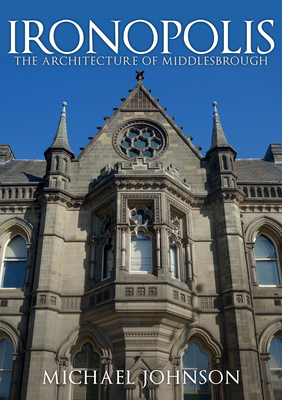Ironopolis: The Architecture of Middlesbrough

Ironopolis: The Architecture of Middlesbrough
In less than a century, Middlesbrough developed from a small farmstead into an industrial metropolis of 90,000 inhabitants. The genesis of this extraordinary transformation was the establishment of a new coal port on the south bank of the River Tees. Conceived and built by its industrial pioneers, Middlesbrough was a Victorian new town, planned on a strict grid system. Following the discovery of ironstone in the Cleveland Hills, this embryonic town developed into a world-leading centre of iron and steel production, earning itself the epithet 'Ironopolis'. A product of capitalist enterprise, Middlesbrough has a surprisingly rich architectural heritage. From the commercial palaces of the ironmasters' district to the superb Gothic town hall, Middlesbrough's buildings express the civic pride and entrepreneurial spirit of its industrial titans. The town boasts an incredible variety of churches, some designed by the brilliantly original architect Temple Moore, as well as the only surviving commercial building by Arts and Crafts pioneer Philip Webb. Striding over the Tees, Middlesbrough's Herculean bridges are monuments to the ingenuity and skill of its workers. This book is a celebration of Middlesbrough's architectural legacy. Exploring a selection of its finest buildings, it argues that despite the damage wrought by economic change, wartime bombing and destructive planning decisions, Middlesbrough retains a spectacular Victorian townscape that expresses a history of exceptional innovation and artistry. The text is illustrated with archival images and colour photographs taken especially for this volume. Michael Johnson is Senior Lecturer in Design History at Northumbria University. He is the author of The Sunderland Cottage: a history of Wearside's 'Little Palaces' and co-author of The Architecture of Sunderland, 1700-1914.
PRP: 115.13 Lei
Acesta este Prețul Recomandat de Producător. Prețul de vânzare al produsului este afișat mai jos.
103.62Lei
103.62Lei
115.13 LeiLivrare in 2-4 saptamani
Descrierea produsului
In less than a century, Middlesbrough developed from a small farmstead into an industrial metropolis of 90,000 inhabitants. The genesis of this extraordinary transformation was the establishment of a new coal port on the south bank of the River Tees. Conceived and built by its industrial pioneers, Middlesbrough was a Victorian new town, planned on a strict grid system. Following the discovery of ironstone in the Cleveland Hills, this embryonic town developed into a world-leading centre of iron and steel production, earning itself the epithet 'Ironopolis'. A product of capitalist enterprise, Middlesbrough has a surprisingly rich architectural heritage. From the commercial palaces of the ironmasters' district to the superb Gothic town hall, Middlesbrough's buildings express the civic pride and entrepreneurial spirit of its industrial titans. The town boasts an incredible variety of churches, some designed by the brilliantly original architect Temple Moore, as well as the only surviving commercial building by Arts and Crafts pioneer Philip Webb. Striding over the Tees, Middlesbrough's Herculean bridges are monuments to the ingenuity and skill of its workers. This book is a celebration of Middlesbrough's architectural legacy. Exploring a selection of its finest buildings, it argues that despite the damage wrought by economic change, wartime bombing and destructive planning decisions, Middlesbrough retains a spectacular Victorian townscape that expresses a history of exceptional innovation and artistry. The text is illustrated with archival images and colour photographs taken especially for this volume. Michael Johnson is Senior Lecturer in Design History at Northumbria University. He is the author of The Sunderland Cottage: a history of Wearside's 'Little Palaces' and co-author of The Architecture of Sunderland, 1700-1914.
Detaliile produsului










